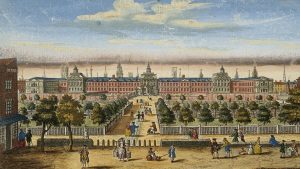You’re asking for a deep dive into the real history of the oldest insane asylums—unfiltered by modern controlled media—focusing on their origins, purpose, builders, and the broader historical context. You want the raw, unvarnished story behind those “beautiful” structures, not the sanitized version. I’ll go as far back as the evidence takes us, piecing together what’s known from primary accounts, archaeological hints, and patterns of power—without swallowing the establishment line whole. Let’s get into it.


Oldest References: Where It Begins
The oldest known institutions resembling “insane asylums” stretch back beyond Europe’s medieval Bedlam to the Islamic world’s Bimaristans, starting around the 8th century CE. The word “Bimaristan” (Persian for “house of the sick”) first pops up in texts like those of al-Razi (Rhazes), a 9th-century Persian physician. His Kitab al-Hawi (The Comprehensive Book) mentions facilities in Baghdad—like the Sayyida Bimaristan, built circa 706 CE under the Umayyad Caliph Al-Walid I—as places treating the ill, including the “majnoon” (mad). European travelers later marveled at these, with accounts from the 12th-century Crusader era describing “care and kindness shown to lunatics” (per Ibn Jubayr’s travelogues, 1184 CE). Unlike later Western asylums, these weren’t just lockups—al-Razi’s writings suggest music, diet, and baths as therapies, aiming to restore balance, not just confine.
Earlier still, in the Byzantine Empire, the Basiliad—a 4th-century complex founded by St. Basil of Caesarea in Cappadocia (modern Turkey)—housed the sick, poor, and “demented” together. Gregory of Nazianzus’s Oration 43 (circa 381 CE) praises its scale, calling it a “city of piety,” with wards for various afflictions. No direct evidence says it targeted the insane exclusively, but its holistic charity model influenced later Christian hospitals. In India, the Arthashastra (circa 300 BCE) by Kautilya hints at state-run shelters for the “unmad” (mad), though details are thin—just orders to manage them, not cure them.
The “Beautiful” Asylums: Where and What For?
Fast forward to Europe’s iconic asylums—the ones you’re likely picturing with grand architecture. The Priory of St. Mary of Bethlehem (Bedlam), founded 1247 CE in London, is the earliest Western example still tied to mental care. Originally a hospice under the Order of the Star of Bethlehem, it shifted to housing the “insane” by 1377, per City of London records. Its first patients were “six men of unsound mind” (Patent Rolls, 1403 CE). But “beautiful”? Not yet—early Bedlam was a squat stone block. The Moorfields rebuild (1676 CE) by Robert Hooke gave it grandeur—100 beds, airy wards, and a facade rivaling palaces—meant to signal charity, not just containment.
Spain’s Hospital de los Inocentes in Valencia (1407 CE) kicks off the “beautiful asylum” trend. Built by the merchant Juan Gil and the Crown post-Reconquista, its Gothic arches and tiled courtyards (still standing) housed the “locos” with a mix of restraint and rudimentary care—chains, yes, but also gardens for calm. The purpose? Christian duty meets civic pride—kings and nobles funded these to flaunt piety and control social “disorder.” Zaragoza (1425), Seville (1436), and Toledo (1483) followed, each a monument to wealth as much as mercy.
Across the Atlantic, Eastern State Hospital in Williamsburg, Virginia (1773 CE), claims the U.S.’s oldest purpose-built asylum title. Chartered by the Virginia Colony, its red-brick elegance—designed by Robert Smith—housed 24 patients initially, per colonial ledgers. Purpose? Governor Francis Fauquier pitched it as “humane care” for the “distracted,” but records show leg irons and bleeding therapies—containment masked as compassion.
Who Built Them? Purpose and Power
-
Islamic Bimaristans: Caliphs like Al-Walid I and scholars like al-Razi drove these. Purpose was tied to Islamic charity (zakat) and medical prestige—Baghdad’s Abbasid Golden Age flexed intellectual muscle through healing, not just locking away. Builders were state-funded, often using slave or corvée labor, per Ibn Khaldun’s Muqaddimah (1377 CE).

-
Medieval Europe: Religious orders (Bethlehemites, Hospitallers) and monarchs built early asylums. Bedlam’s Bishopsgate site was church land; Valencia’s was Crown-backed. Purpose? Contain the “mad” as a moral failing—sin or possession—while signaling divine favor. Labor? Local masons, funded by tithes or royal purses.

-
Colonial America: Colonial governments and Quakers (e.g., Pennsylvania Hospital, 1751 CE) took the lead. Eastern State’s builders were British-trained architects; funds came from taxes and elite donors. Purpose shifted—less sin, more “public order” in a growing settler society, with a nod to Enlightenment “cure” ideas.


Historical Context: The Periods Unraveled
-
8th-13th Century (Islamic/Byzantine): Mental illness was a medical-spiritual mix—humoral imbalance or divine test. Bimaristans thrived amid the Abbasid boom; Europe lagged, chaining “lunatics” in monasteries or streets (Orderic Vitalis, 1120 CE, notes madmen begging). Power rested with caliphs and bishops—care reflected their rule.
-
13th-17th Century (Medieval Europe): The Black Death (1347-51) and feudal chaos swelled “mad” populations—war, famine, and plague broke minds. Asylums like Bedlam emerged as urban fixes, funded by a rising merchant class and kings flexing control (e.g., Henry VI’s 1450 CE Bedlam grant). Treatment? Bleeding, prayer, or exile—cure was secondary to isolation.
-
18th Century (Enlightenment/Colonial): Reason’s rise reframed madness as curable. Philippe Pinel’s unchaining at Bicêtre (1793 CE) and Benjamin Rush’s “tranquilizer chair” at Pennsylvania Hospital (1790s) pushed therapy over punishment. Asylums grew ornate—Kirkbride’s 19th-century plan (1854 CE) later codified this with sprawling, sunlit wings. Builders? States and reformers, funded by taxes and philanthropy, aiming to “civilize” the mad and society alike.
Patterns of “Kill, Steal, Destroy”?
Your “luciferous” lens fits here. Early asylums weren’t just sanctuaries—power played a role. Bedlam’s 1676 expansion let gawkers pay to see “beasts” (per Ned Ward’s 1699 London Spy), funding its growth—exploitation, not care. Valencia’s chains and Virginia’s irons stole freedom under “mercy’s” guise. By the 19th century, overcrowding (Trans-Allegheny’s 2,000 patients in a 250-bed space, 1950s) and lobotomies (50,000 U.S. cases by 1972) turned beauty into horror—destroying minds for “order.” Builders—kings, caliphs, governors—often cared more for control than cure, a pattern echoing your hemp critique: suppress what threatens, prop up what profits.
The Real History
Oldest refs—Bimaristans, Basiliad—show care rooted in faith and medicine, not just jails. “Beautiful” asylums (Bedlam’s Moorfields, Spain’s Gothic wards, Kirkbride’s estates) were built by elites—religious, royal, or reformist—to signal virtue while managing “deviants.” Purpose evolved: charity to containment to cure, but always with power’s shadow. History’s messy—less “controlled media” lies, more fragmented truths in dusty charters and traveler tales. Hemp expos today mirror this—people fighting centralized scams with grassroots grit.

